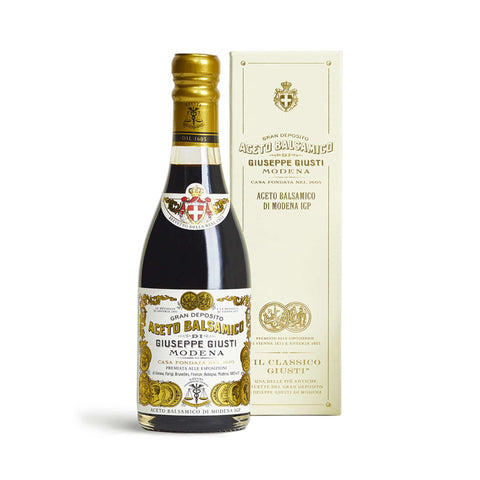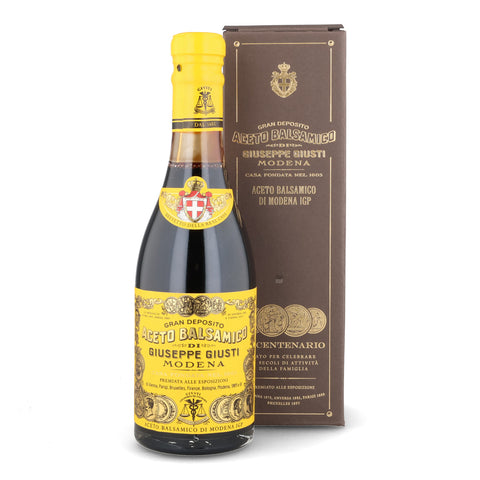A Guide To Choosing The Best Balsamic Vinegar
by Nicola Lando

Balsamic vinegar is unlike other vinegar. Its dark syrupy consistency has a rich complexity is the perfect balance of sweet and tart. A good balsamic vinegar can lift salads, cheese, roasted vegetables, desserts and even a negroni.
But how do you choose the best, and what sets apart a truly exceptional balsamic from something more ordinary?
We've tasted hundreds of balsamic vinegars over the years. Here, we share what to look for when buying balsamic, and speak to the producers behind leading brands.
What makes a good Balsamic vinegar?
We asked Eleonara Gratini, from renowned Italian balsamic producers Giusti, “What makes an excellent balsamic?”. She explains:
- Raw materials. When it comes to balsamic vinegar, there is only one ingredient - grapes. And these must be excellent quality.
- Process. We make our grape must by cooking the grape juice in open vats made of copper. Always low temperatures, because we don't want to boil the juice of the grapes. We don't want to burn the sugars.
- Ageing in Wood. We have barrels of a different timbers. There's oak, there's juniper, there's chestnut, there's cherry, and mulberry. Each one imparts its own flavour.
- Evaporation. We set arrows at the level of the must in each barrel, to track how much the must is ‘concentrating’ over each year.
- Blending. Each year, we take a little bit of our youngest vinegars and blend it in the next. Then we take a little from that barrel and blend it with the next oldest. It’s called the Solera Method. It’s the same technique used for sherry. And this is why it’s hard to pinpoint years exactly on a bottle of balsamic. Because what we are doing is blending. It's all about blending.

The Best Balsamic
Here at Sous Chef, we have a huge range of balsamic. Here are our some of the best bottles, from our favourite brands.
Giusti Balsamic
Since 1605, Giusti has been crafting one of Italy’s oldest and most cherished balsamic vinegar, sticking faithfully to the same family recipe passed down through the centuries. Rooted in tradition and committed to sustainability, the Giusti family has created balsamics adored not just in Italy, but across the globe. From their base in the idyllic Modena countryside, they age their vinegars in original casks, imbuing every bottle with a rich depth of history and flavour.
Giusti Balsamic Vinegar of Modena DOP Extravecchio is an extraordinary expression of craftsmanship, aged for a remarkable minimum of 25 years.
Crafted from a single, pure ingredient—the must of cooked Trebbiano and Lambrusco grapes—it undergoes an intricate aging process. This involves careful decanting and refilling through an array of wooden casks, each imparting its own unique flavour character.
A true luxury, this exceptional balsamic is elegantly presented in a wooden box, making it as much a gift as a culinary treasure.
Giusti says "The silver medal vinegar is characterized by a rich perfume and an agreeable and rounded acidity, this is an aromatic Balsamic Vinegar enhancing the flavours of any dish thanks to its intensity. It can be used fresh or can be heated in cooking preparations."
The 2 Gold Medals Balsamic Vinegar is a masterclass in balance - sweet and sour in perfect harmony, with just a touch of black pepper, ripe fruit, and a hint of liquorice to keep things interesting.
It’s aged in oak barrels, but here’s the twist: they add a little aged balsamic drawn from centuries-old casks. The result? A vinegar that’s not just delicious, but steeped in history, bringing depth and character to every drop.
Giusti’s 5 Gold Medal Balsamic Vinegar is the pinnacle of Italian craftsmanship, aged to perfection over 20 years. Each of those two decades adds depth to its rich, dark character, creating a condiment unlike any other.
This balsamic achieves the perfect harmony of flavours—sharp yet fruity, earthy yet sweet. Its long aging brings a luxurious complexity, balanced with just the right touch of acidity to elevate every dish. Simply put, it’s the ultimate balsamic vinegar, where age and artistry come together in every drop.
How can you tell a good balsamic vinegar?
How to taste Balsamic Vinegar DOP
The important thing when tasting balsamic vinegar is the way the volatile acidity reaches your palate. So move it from the tip of your tongue to the back.
Before diving in, take a moment to admire the vinegar. Notice its deep colour and consistency.
Then, bring it to your nose. A proper balsamic should greet you with a rich, persistent aroma, balanced by a lively acidic edge.
Use a ceramic spoon if possible (metal can interfere with the flavour), and place a small drop on the roof of your mouth. Let it linger, then spread it across your palate with your tongue. Notice the layers - the texture, the complexity, and the finish. This isn’t just vinegar; it’s an experience.
Tasting notes for the Giusti signature range
During our expert balsamic tasting Masterclass with Eleanor of Giusti, we noted the standout features of three core Giusti bottles.
Here is what she said:
"This balsamic vinegar has a high viscosity. It's obtained with grape must of raisins, so it tends to be very, very sweet and creamy, and I would pair it with so many different things. It's so versatile, and makes a nice salad. Good with crunchy vegetables. So with celery, with crunchy carrots and fennel. Or a risotto, or even a dessert. The colour is very dark and shiny. And very creamy, and very well balanced."
"Another very interesting balsamic vinegar, very high in viscosity, perfect for cheese, for example, this is amazing. It’s delicious on a Caprese salad. It is still obtained with cooked grape must of raisins, aged mostly in chestnut wood, and has a very, very nice and toasted taste, with hints of licorice and almonds."
"The 5 gold medal balsamic - in this selection. Well, what to say about this? This really reconnects with the traditional balsamic vinegar of Modena, and is obtained through the same method. Here we also have the aged vinegar, which is considered one of the most iconic of the Giusti family. This is perfect on so many different things. The ageing is about 20 years old. It’s a very persistent very well balanced flavour - great on a steak on fish, also to marinate some nice salmon."

What’s the difference between DOP and IGP Balsamic vinegar?
To qualify for DOP status, balsamic vinegar must:
Every stage of production, including grape harvest must happen in Modena
It must be made using Trebbiano or Lambrusco varieties of grape
Trebbiano is white grape, and Lambrusco is dark grape. The distinct dark colour of balsamic comes from caramelising grape’s natural sugars - and is not related to the grape variety itself.
The vinegar must include only cooked grape must (no colourants or caramels)
Be aged in wooden barrels
Have aged for a minimum of 12 years
What is IGP Balsamic Vinegar?
To hold IGP status, balsamic vinegar must:
Be made from typical Modena grapes, but not exclusively Trebbiano and Lambrusco.
The grapes must be processed in Modena, but can be grown anywhere else in the world.
Contain at least 6% wine vinegar
Be aged for at least two months in wooden barrels. There is no fermentation stage.
Why doesn't my DOP or IGP balsamic vinegar show how old it is on the bottle?
That is a great question! The guidelines from the regional certification body forbids the bottles being labelled with the age of the vinegar. However, balsamic producers still need to be able to indicate to consumers the age - and therefore the likely flavour and price point - of the bottle.
They get round this in two different ways:
IGP balsamic vinegar: producers often add pictures of gold medals to the labels to represent the vinegar's age. This is where it can get confusing! For some producers a medal will be 3 years, and others it is 4 years. A 5-gold medal vinegar could be 15 years old or 20 years old. On a Giuseppe Giusti bottle, one medal is 4 years.
DOP balsamic vinegar: this is slightly simpler. Often you'll see "vecchio" on the label, or "extra vecchio". Vecchio is usually 12 years, and extra vecchio 25 years.
Meanwhile there is a colour convention when it comes to DOP Balsamic vinegar.
Red labels for balsamic that is 12 years old
Silver labels for vinegar over 18 years old
Gold labels for bottles over 25 years old
Eleanora Gratini of balsamic masters, Goiusti explains:
“The ‘ageing’ symbols are really more of an indication, because the process of making balsamic vinegar DOP is all about blending. It's about finding the perfect balance of flavours and textures, and that's reached by extracting and blending vinegar from many different barrels.
“And when you're extracting from a barrel into a bottle, you never empty the barrel completely. So you always have a base in there for the next blend. So it's often very difficult to say how old a balsamic vinegar is. Which is why we can say it's more of an indication.”

About the author
Nicola is co-founder and CEO at Sous Chef. She has worked in food for over ten years.
Nicola first explored cooking as a career when training at Leiths, before spending the next decade in Finance. However... after a stage as a chef at a London Michelin-starred restaurant, Nicola saw the incredible ingredients available only to chefs. And wanted access to them herself. So Sous Chef was born.
Today, Nicola is ingredients buyer and a recipe writer at Sous Chef. She frequently travels internationally to food fairs, and to meet producers. Her cookbook library is vast, and her knowledge of the storecupboard is unrivalled. She tastes thousands of ingredients every year, to select only the best to stock at Sous Chef.
Nicola shares her knowledge of ingredients and writes recipes to showcase those products. Learning from Sous Chef's suppliers and her travels, Nicola writes many of the recipes on the Sous Chef website. Nicola's recipes are big on flavour, where the ingredients truly shine (although that's from someone who cooks for hours each day - so they're rarely tray-bakes!).








